Salah H. Abid, Russul K. Abdulrazak
Mathematics department, Education College, Al-Mustansiriya University, Baghdad, Iraq
Correspondence to: Salah H. Abid, Mathematics department, Education College, Al-Mustansiriya University, Baghdad, Iraq.
| Email: |  |
Copyright © 2017 Scientific & Academic Publishing. All Rights Reserved.
This work is licensed under the Creative Commons Attribution International License (CC BY).
http://creativecommons.org/licenses/by/4.0/

Abstract
In this paper, we introduce a new family of continuous distributions based on [0,1] truncated Fréchet distribution. [0,1] truncated Fréchet Uniform ([0,1] TFU ) and [0,1] truncated Fréchet Exponential ([0,1] TFE ) distributions are discussed as special cases. The cumulative distribution function, the rth moment, the mean, the variance, the skewness, the kurtosis, the mode, the median, the characteristic function, the reliability function and the hazard rate function are obtained for the distributions under consideration. It is well known that an item fails when a stress to which it is subjected exceeds the corresponding strength. In this sense, strength can be viewed as “resistance to failure”. Good design practice is such that the strength is always greater than the expected stress. The safety factor can be defined in terms of strength and stress as strength/ stress. So, the [0,1] TFU strength-stress and the [0,1] TFE strength-stress models with different parameters will be derived here. The Shannon entropy and Relative entropy will be derived also.
Keywords:
[0,1] TFU, [0,1] TFE, Stress-strength model, Shannon entropy, Relative entropy
Cite this paper: Salah H. Abid, Russul K. Abdulrazak, [0,1] Truncated Fréchet-Uniform and Exponential Distributions, American Journal of Systems Science, Vol. 5 No. 1, 2017, pp. 13-27. doi: 10.5923/j.ajss.20170501.02.
1. Introduction
Here, we proposed a distribution with the hope it will attract wider applicability in other fields. The generalization which is motivated by the work of Eugene et al. [2] will be our guide. Eugene et al. (2002) defined the beta G distribution from a quite arbitrary cumulative distribution function (cdf), G(x) by | (1) |
where a > 0 and b > 0 are two additional parameters whose role is to introduce skewness and to vary tail weight and  is the beta function. The class of distributions (1) has an increased attention after the works by Eugene et al. (2002) [2] and Jones (2004) [5]. Application of
is the beta function. The class of distributions (1) has an increased attention after the works by Eugene et al. (2002) [2] and Jones (2004) [5]. Application of  to the random variable V following a beta distribution with parameters a and b, V ∼ B(a, b) say, yields X with cdf (1). Eugene et al. (2002) defined the beta normal (BN) distribution by taking G(x) to be the cdf of the normal distribution and derived some of its first moments. General expressions for the moments of the BN distribution were derived (Gupta and Nadarajah, 2004) [4]. An extensive review of scientific literature on this subject is available in Abid and Hassan (2015) [1]. We can write (1) as,
to the random variable V following a beta distribution with parameters a and b, V ∼ B(a, b) say, yields X with cdf (1). Eugene et al. (2002) defined the beta normal (BN) distribution by taking G(x) to be the cdf of the normal distribution and derived some of its first moments. General expressions for the moments of the BN distribution were derived (Gupta and Nadarajah, 2004) [4]. An extensive review of scientific literature on this subject is available in Abid and Hassan (2015) [1]. We can write (1) as, | (2) |
Where,  denotes the incomplete beta function ratio, i.e., the cdf of the beta distribution with parameters a and b. For general a and b, we can express (2) in terms of the well-known hypergeometric function defined by,
denotes the incomplete beta function ratio, i.e., the cdf of the beta distribution with parameters a and b. For general a and b, we can express (2) in terms of the well-known hypergeometric function defined by,  Where
Where  denotes the ascending factorial. We obtain,
denotes the ascending factorial. We obtain, The properties of the cdf, F(x) for any beta
The properties of the cdf, F(x) for any beta  distribution defined from a parent
distribution defined from a parent  in (1), could, in principle, follow from the properties of the hypergeometric function which are well established in the literature; see, for example, Section 9.1 of Gradshteyn and Ryzhik (2000) [3]. The probability density function (pdf) corresponding to (1) can be written in the form,
in (1), could, in principle, follow from the properties of the hypergeometric function which are well established in the literature; see, for example, Section 9.1 of Gradshteyn and Ryzhik (2000) [3]. The probability density function (pdf) corresponding to (1) can be written in the form, | (3) |
where  is the pdf of the parent distribution.Now, since the pdf and cdf of [0,1] truncated Fréchet distribution are respectively,
is the pdf of the parent distribution.Now, since the pdf and cdf of [0,1] truncated Fréchet distribution are respectively,  | (4) |
 | (5) |
Graphs for some arbitrary parameters values of pdf and cdf are shown in figure (1) and figure (2) respectively, | Figure 1 and 2 |
Now, Given two absolutely continuous cdfs, H and G, so that h and g are their corresponding pdfs. We suggest a new distribution F by composing H with G, so that  is a CDF,
is a CDF, | (6) |
With pdf,  | (7) |
With  being a baseline distribution, we define in (6) and (7) above, a generalized class of distributions. We will name it the [0,1] truncated Fréchet -G distribution. In the following two sections, we will assume that G are Uniform and Exponential distributions respectively.
being a baseline distribution, we define in (6) and (7) above, a generalized class of distributions. We will name it the [0,1] truncated Fréchet -G distribution. In the following two sections, we will assume that G are Uniform and Exponential distributions respectively.
2. [0,1] Truncated Fréchet Uniform Distribution
Assume that  and
and 
 are pdf and cdf of Uniform random variable respectively, then, by applying (6) and (7) above, we get the cdf and pdf of [0,1] TFU random variable as follows,
are pdf and cdf of Uniform random variable respectively, then, by applying (6) and (7) above, we get the cdf and pdf of [0,1] TFU random variable as follows,  | (8) |
 | (9) |
So, the reliability and hazard rate functions are respectively 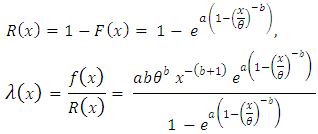 The rth raw moment can be derived as follows,
The rth raw moment can be derived as follows,  let
let  then,
then, | (10) |
And then, the characteristic function is 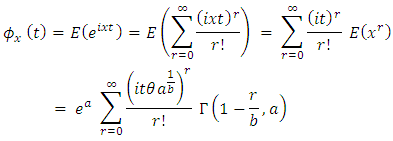 So, the mean and variance of the of [0,1] TFU random variable are,
So, the mean and variance of the of [0,1] TFU random variable are, | (11) |
 | (12) |
The mode  and the median
and the median  can be derived as,
can be derived as, 
 | (13) |
 | (14) |
The skewness of [0,1] TFU random variable will be,  | (15) |
Also, the kurtosis is, 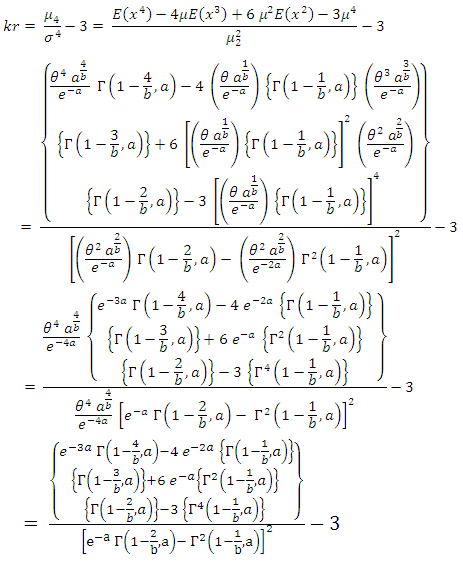 | (16) |
The quantile function  of [0,1] TFU random variable can be derived as,
of [0,1] TFU random variable can be derived as,  | (17) |
So by using the inverse transform method, we can generate [0,1] TFU random variable as follows,  Where
Where  is a random number distributed uniformly in the unit interval [0,1].
is a random number distributed uniformly in the unit interval [0,1].
2.1. Shannon and Relative Entropies
An entropy of a random variable  is a measure of variation of the uncertainty. The Shannon entropy of
is a measure of variation of the uncertainty. The Shannon entropy of  random variable
random variable  can be found as follows,
can be found as follows, Let
Let  let
let  then,
then,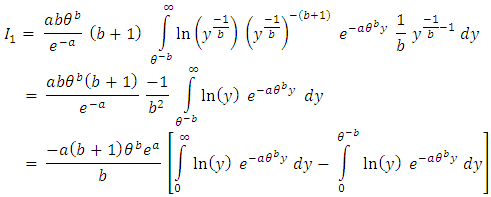 Since
Since  where
where  and
and  is an Euler constant, then
is an Euler constant, then  For,
For,  let
let  then,
then, since
since  then,
then,  let
let  then,
then,
 then the Shannon entropy is
then the Shannon entropy is | (18) |
The relative entropy (or the Kullback–Leibler divergence) is a measure of the difference between two probability distributions  and
and  It is not symmetric in
It is not symmetric in  and
and  In applications,
In applications,  typically represents the "true" distribution of data, observations, or a precisely calculated theoretical distribution, while
typically represents the "true" distribution of data, observations, or a precisely calculated theoretical distribution, while  typically represents a theory, model, description, or approximation of
typically represents a theory, model, description, or approximation of  Specifically, the Kullback–Leibler divergence of
Specifically, the Kullback–Leibler divergence of  from
from  denoted
denoted  is a measure of the information gained when one revises ones beliefs from the prior probability distribution
is a measure of the information gained when one revises ones beliefs from the prior probability distribution  to the posterior probability distribution
to the posterior probability distribution  More exactly, it is the amount of information that is lost when
More exactly, it is the amount of information that is lost when  is used to approximate
is used to approximate  defined operationally as the expected extra number of bits required to code samples from
defined operationally as the expected extra number of bits required to code samples from  using a code optimized for
using a code optimized for  rather than the code optimized for
rather than the code optimized for  So, the relative entropy
So, the relative entropy  for a random variable
for a random variable  can be found as follows,since,
can be found as follows,since,  then
then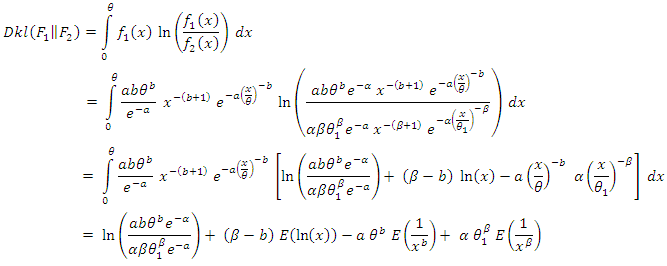 Since,
Since,  And,
And,  And,
And,  let
let  then,
then,  so the relative entropy is,
so the relative entropy is, | (19) |
2.2. Stress-Strength Reliability
Inferences about R = P[Y < X], where X and Y are two independent random variables, is very common in the reliability literature. For example, if X is the strength of a component which is subject to a stress Y, then R is a measure of system performance and arises in the context of mechanical reliability of a system. The system fails if and only if at any time the applied stress is greater than its strength. Let Y and X be the stress and the strength random variables, independent of each other, follow respectively  and
and  then,
then, since
since  then,
then, let
let  so,
so,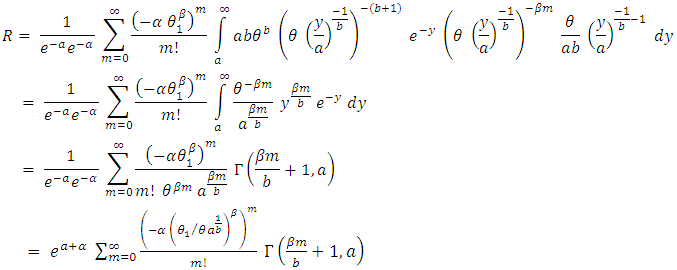 | (20) |
3. [0,1] Truncated Fréchet Exponential Distribution
Assume that  and
and  are pdf and cdf of Exponential random variable respectively, then, by applying (6) and (7) above, we get the pdf and cdf of [0,1] TFE random variable as follows,
are pdf and cdf of Exponential random variable respectively, then, by applying (6) and (7) above, we get the pdf and cdf of [0,1] TFE random variable as follows,  | (21) |
 | (22) |
So, the reliability  and hazard rate
and hazard rate  functions are respectively
functions are respectively 
 The rth raw moment can be derived as follows,
The rth raw moment can be derived as follows,  by using poisson series,
by using poisson series,  we get,
we get, By using the series expansion
By using the series expansion  we get,
we get, and then,
and then, | (23) |
And then, the characteristic function is  So, the mean
So, the mean  and variance
and variance  of the of [0,1] TFE random variable are,
of the of [0,1] TFE random variable are, | (24) |
 | (25) |
The mode  has not closed form, whilst the median
has not closed form, whilst the median  can be derived as, Since,
can be derived as, Since,  then,
then, | (26) |
The skewness of [0,1] TFE random variable will be,  | (27) |
Also, the kurtosis is,  | (28) |
The quantile function  of [0,1] TFE random variable can be derived as,
of [0,1] TFE random variable can be derived as,  | (29) |
So by using the inverse transform method, we can generate [0,1] TFE random variable as follows,  Where
Where  is a random number distributed uniformly in the unit interval [0,1].
is a random number distributed uniformly in the unit interval [0,1].
3.1. Shannon and Relative Entropies
The Shannon entropy of  random variable
random variable  can be found as follows,
can be found as follows,  Let,
Let, 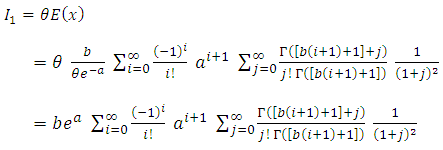 And,
And, 

 since
since  where
where 
 is an Eualer constant.
is an Eualer constant.  since
since  And
And 
 And,
And,  since
since  then,
then,  By using the series expansion
By using the series expansion  we get,
we get, then,
then, | (30) |
The relative entropy  for a random variable
for a random variable  can be found as follows,
can be found as follows,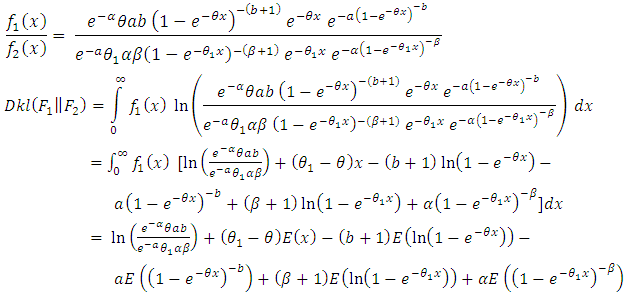 Let,
Let,  And,
And,  And,
And,  And,
And, 
 Since,
Since,  then,
then, by using expansion series
by using expansion series  we get,
we get, and then,
and then, by using the for formala
by using the for formala  we get,
we get, and then,
and then, since
since  then,
then, And,
And, 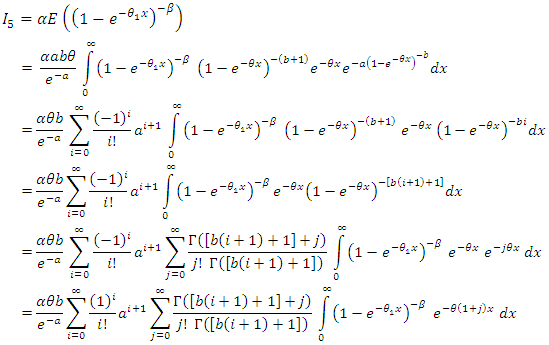 By using,
By using,  we get,
we get, Then, the relative entropy is,
Then, the relative entropy is,  | (31) |
3.2. Stress-Strength Reliability
Let Y and X be the stress and the strength random variables, independent of each other, follow respectively  and
and  then,
then, since
since  then,
then, So, by using,
So, by using,  we get,
we get, And using,
And using,  then,
then, | (32) |
Where, 
4. Summary and Conclusions
In statistical analysis, a lot of distributions are used to represent set(s) data. Recently .New distributions are derived to extend some of well-known families of distributions, such that the new distributions are more flexible than the others to model real data. The composing of some distributions with each other's in some way has been in the foreword of data modeling. In this paper,, we presented a new family of continuous distributions based on [0,1] truncated Fréchet distribution. [0,1] truncated Fréchet Uniform ([0,1] TFU ) and [0,1] truncated Fréchet Exponential ([0,1] TFE ) distributions are discussed as special cases. Properties of [0,1] TFU and [0,1] TFE is derived. We provide forms for characteristic function, rth raw moment, mean, variance, skewness, kurtosis, mode, median, reliability function, hazard rate function, Shannon entropy function and Relative entropy function. This paper deals also with the determination of stress-strength reliability R = P[Y < X] when X (strength) and Y (stress) are two independent [0,1] TFU ([0,1] TFE) distributions with different parameters.
References
| [1] | Abid, S., Hassan, H. (2015) "The Beta Marshall-Olkin Extended Uniform Distribution"; Journal of Safety Engineering 2015, 4(1): 1-7. |
| [2] | Eugene, N., Lee, C., Famoye, F. (2002) "Beta-normal distribution and its applications" Commun.Statist. - Theory and Methods 31:497-512. |
| [3] | Gradshteyn, I.S., Ryzhik, I.M. (2000) "Table of integrals, series, and products" Academic Press, San Diego. |
| [4] | Gupta, A.K., Nadarajah, S. (2004) "On the moments of the beta normal distribution" Commun. Statist. - Theory and Methods 33:1-13. |
| [5] | Jones, M.C. (2004) "Families of distributions arising from distributions of order statistics" Test 13:1-43. |




 is the beta function. The class of distributions (1) has an increased attention after the works by Eugene et al. (2002) [2] and Jones (2004) [5]. Application of
is the beta function. The class of distributions (1) has an increased attention after the works by Eugene et al. (2002) [2] and Jones (2004) [5]. Application of  to the random variable V following a beta distribution with parameters a and b, V ∼ B(a, b) say, yields X with cdf (1). Eugene et al. (2002) defined the beta normal (BN) distribution by taking G(x) to be the cdf of the normal distribution and derived some of its first moments. General expressions for the moments of the BN distribution were derived (Gupta and Nadarajah, 2004) [4]. An extensive review of scientific literature on this subject is available in Abid and Hassan (2015) [1]. We can write (1) as,
to the random variable V following a beta distribution with parameters a and b, V ∼ B(a, b) say, yields X with cdf (1). Eugene et al. (2002) defined the beta normal (BN) distribution by taking G(x) to be the cdf of the normal distribution and derived some of its first moments. General expressions for the moments of the BN distribution were derived (Gupta and Nadarajah, 2004) [4]. An extensive review of scientific literature on this subject is available in Abid and Hassan (2015) [1]. We can write (1) as,
 denotes the incomplete beta function ratio, i.e., the cdf of the beta distribution with parameters a and b. For general a and b, we can express (2) in terms of the well-known hypergeometric function defined by,
denotes the incomplete beta function ratio, i.e., the cdf of the beta distribution with parameters a and b. For general a and b, we can express (2) in terms of the well-known hypergeometric function defined by,  Where
Where  denotes the ascending factorial. We obtain,
denotes the ascending factorial. We obtain, The properties of the cdf, F(x) for any beta
The properties of the cdf, F(x) for any beta  distribution defined from a parent
distribution defined from a parent  in (1), could, in principle, follow from the properties of the hypergeometric function which are well established in the literature; see, for example, Section 9.1 of Gradshteyn and Ryzhik (2000) [3]. The probability density function (pdf) corresponding to (1) can be written in the form,
in (1), could, in principle, follow from the properties of the hypergeometric function which are well established in the literature; see, for example, Section 9.1 of Gradshteyn and Ryzhik (2000) [3]. The probability density function (pdf) corresponding to (1) can be written in the form,
 is the pdf of the parent distribution.Now, since the pdf and cdf of [0,1] truncated Fréchet distribution are respectively,
is the pdf of the parent distribution.Now, since the pdf and cdf of [0,1] truncated Fréchet distribution are respectively, 


 is a CDF,
is a CDF,

 being a baseline distribution, we define in (6) and (7) above, a generalized class of distributions. We will name it the [0,1] truncated Fréchet -G distribution. In the following two sections, we will assume that G are Uniform and Exponential distributions respectively.
being a baseline distribution, we define in (6) and (7) above, a generalized class of distributions. We will name it the [0,1] truncated Fréchet -G distribution. In the following two sections, we will assume that G are Uniform and Exponential distributions respectively. and
and 
 are pdf and cdf of Uniform random variable respectively, then, by applying (6) and (7) above, we get the cdf and pdf of [0,1] TFU random variable as follows,
are pdf and cdf of Uniform random variable respectively, then, by applying (6) and (7) above, we get the cdf and pdf of [0,1] TFU random variable as follows, 

 The rth raw moment can be derived as follows,
The rth raw moment can be derived as follows,  let
let  then,
then,
 So, the mean and variance of the of [0,1] TFU random variable are,
So, the mean and variance of the of [0,1] TFU random variable are,

 and the median
and the median  can be derived as,
can be derived as, 




 of [0,1] TFU random variable can be derived as,
of [0,1] TFU random variable can be derived as, 
 Where
Where  is a random number distributed uniformly in the unit interval [0,1].
is a random number distributed uniformly in the unit interval [0,1]. is a measure of variation of the uncertainty. The Shannon entropy of
is a measure of variation of the uncertainty. The Shannon entropy of  random variable
random variable  can be found as follows,
can be found as follows, Let
Let  let
let  then,
then, Since
Since  where
where  and
and  is an Euler constant, then
is an Euler constant, then  For,
For,  let
let  then,
then, since
since  then,
then,  let
let  then,
then,
 then the Shannon entropy is
then the Shannon entropy is
 and
and  It is not symmetric in
It is not symmetric in  and
and  In applications,
In applications,  typically represents the "true" distribution of data, observations, or a precisely calculated theoretical distribution, while
typically represents the "true" distribution of data, observations, or a precisely calculated theoretical distribution, while  typically represents a theory, model, description, or approximation of
typically represents a theory, model, description, or approximation of  Specifically, the Kullback–Leibler divergence of
Specifically, the Kullback–Leibler divergence of  from
from  denoted
denoted  is a measure of the information gained when one revises ones beliefs from the prior probability distribution
is a measure of the information gained when one revises ones beliefs from the prior probability distribution  to the posterior probability distribution
to the posterior probability distribution  More exactly, it is the amount of information that is lost when
More exactly, it is the amount of information that is lost when  is used to approximate
is used to approximate  defined operationally as the expected extra number of bits required to code samples from
defined operationally as the expected extra number of bits required to code samples from  using a code optimized for
using a code optimized for  rather than the code optimized for
rather than the code optimized for  So, the relative entropy
So, the relative entropy  for a random variable
for a random variable  can be found as follows,since,
can be found as follows,since,  then
then Since,
Since,  And,
And,  And,
And,  let
let  then,
then,  so the relative entropy is,
so the relative entropy is,
 and
and  then,
then, since
since  then,
then, let
let  so,
so,
 and
and  are pdf and cdf of Exponential random variable respectively, then, by applying (6) and (7) above, we get the pdf and cdf of [0,1] TFE random variable as follows,
are pdf and cdf of Exponential random variable respectively, then, by applying (6) and (7) above, we get the pdf and cdf of [0,1] TFE random variable as follows, 

 and hazard rate
and hazard rate  functions are respectively
functions are respectively 
 The rth raw moment can be derived as follows,
The rth raw moment can be derived as follows,  by using poisson series,
by using poisson series,  we get,
we get, By using the series expansion
By using the series expansion  we get,
we get, and then,
and then,
 So, the mean
So, the mean  and variance
and variance  of the of [0,1] TFE random variable are,
of the of [0,1] TFE random variable are,

 has not closed form, whilst the median
has not closed form, whilst the median  can be derived as, Since,
can be derived as, Since,  then,
then,


 of [0,1] TFE random variable can be derived as,
of [0,1] TFE random variable can be derived as, 
 Where
Where  is a random number distributed uniformly in the unit interval [0,1].
is a random number distributed uniformly in the unit interval [0,1]. random variable
random variable  can be found as follows,
can be found as follows,  Let,
Let,  And,
And, 

 since
since  where
where 
 is an Eualer constant.
is an Eualer constant.  since
since  And
And 
 And,
And,  since
since  then,
then,  By using the series expansion
By using the series expansion  we get,
we get, then,
then,
 for a random variable
for a random variable  can be found as follows,
can be found as follows, Let,
Let,  And,
And,  And,
And,  And,
And, 
 Since,
Since,  then,
then, by using expansion series
by using expansion series  we get,
we get, and then,
and then, by using the for formala
by using the for formala  we get,
we get, and then,
and then, since
since  then,
then, And,
And,  By using,
By using,  we get,
we get, Then, the relative entropy is,
Then, the relative entropy is, 
 and
and  then,
then, since
since  then,
then, So, by using,
So, by using,  we get,
we get, And using,
And using,  then,
then,

 Abstract
Abstract Reference
Reference Full-Text PDF
Full-Text PDF Full-text HTML
Full-text HTML